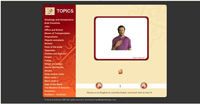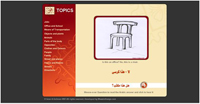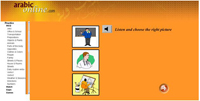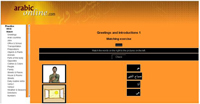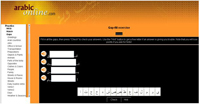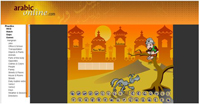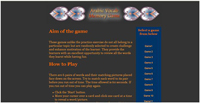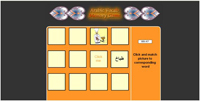
Arabic Vocabulary for Beginners
"Arabic Vocabulary by Topic for Beginners" makes use of technology to present 264 basic-Arabic everyday useful words and phrases grouped under 23 topics to be learned alongside with learning the alphabet and Arabic script.
The topic is chosen to provide each word with limited context for the Novice level learner since his/her limited linguistic background does not allow him/her to read the words repeatedly in authentic contexts. The words within each topic are carefully chosen from survival Arabic dialogues and passages that occur frequently in most Arabic for beginners off the shelf books.
The program aims at:
Who the program is for?
The program is designed for Novice learners with no background of Arabic whatsoever. It could be useful for learners who are already enrolled in an academic course or to any Arabic learner any time any place. The program can be used by students for self-directed learning or by teachers and students to enhance face-to-face learning.
In general, it caters for non-native speakers of Arabic who wish to acquaint themselves with the Arabic language system by learning some vocabulary before committing themselves to a full time Arabic program.
1. Presentation
The presentation section of this vocabulary module focuses on three main features that aid vocabulary comprehension, and retention as well as develop the learners' ability to hear and pronounce Arabic sounds. This is realized through the following strategies:
a- Visualization of lexis (pictures) to help learner create a mental image of meaning
b- Frequent exposure through repetition within the topic-context of the lexical set
c- Focusing on more than one aspect of a word: form (how it is written); sound (how it is said); and meaning (what it means)
d- Using the word in a question answer context to train learners to recognize the words they learn in connected speech
e- Isolating and decontextualizing words to avoid distraction that could occur to a Novice-level learner when faced with a chunk of incomprehensible text (written or audio)
2. Practice
The practice section of "Arabic Vocabulary by Topic for Beginners" helps learners to acquire vocabulary explicitly through enhancing the words they learnt by a set of interactive exercises. The practice section of the program comprises different type of exercises: multiple choice; matching; filling gaps and games. Each type of question set serves a different pedagogic purpose. Following is a breakdown of the exercise types and the aim and description of each practice:
2.1 Multiple Choice (MCQ)
Aim:
The aim of this exercise is to focus the learner's attention on sound and meaning of a particular word
Description:
This exercise allows the learner to listen to a particular word while given 3 choices of images of which only one corresponds to the meaning of the sound s/he hears. The learner chooses the appropriate meaning by clicking on one of the provided pictures. Instant feedback is provided on each click directing the learner to whether s/he was successful or if s/he needs to try again. Since at this stage of practice the pedagogic focus of the exercise is to train and not to test, the learner is allowed to try all three pictures till he reaches the correct meaning.
2.2 Matching
Aim:
The aim of this exercise is to focus the learner's attention on Form and meaning
Description:
On completion of the MCQ exercise pertinent to a particular topic, the learner should move on to the Matching exercise under Practice on the left-hand menu. The learner selects the same topic that he has completed successfully from the drop down menu that appears and starts matching words to their corresponding pictures. The learner is given 3 pictures and four words to match. The number of pictures does not correspond to the number of words to add a difficulty factor to this exercise. The learner starts pulling the text boxes and drops them besides the corresponding pictures. If the learner at any point wishes to go back and repeat the set of words he has done again the places of the pictures are changed to avoid the risk of the learner memorizing the places of words and pictures rather being cognitively involved with the exercise.
2.3 Gap Filling
Aim:
The aim of this exercise is to focus the learner's attention on developing Spelling (Sound and form) of vocabulary
2.4 Vocabulary Games
Aim:
Focus on real life activities for boosting motivation and providing students with collaborative or individualized opportunities for word review
2.4.1 Hangman: Goha in Trouble
Aim:
Goha in Trouble is an interactive version of the popular word guessing game Hangman that aims at expanding vocabulary and developing spelling skills.
Description:
Goha gets into trouble and is stuck on top of a tree with a wolf waiting for him to fall off the tree to devour him. His only way out is the player's right guess of the letters that constitute a particular word displayed as watermark square-prompts on the screen.
The computer selects a word from within the vocabulary of a particular topic which the learner has previously studied. Although the learner has no control on choice of word he selects, he can still choose the topic he wishes to review for the computer to randomly select its words.
To carry on playing, you can either choose a new word from the same topic or go back to the left-hand menu to change the topic and the word.
2.4.2 Memory Game
Aim:
These games unlike the practice exercise do not all belong to a particular topic but are randomly selected to create challenge and enhance motivation of the learner. They provide the learners with an excellent opportunity to review all the words they learnt while having fun.
How to play:
There are 6 pairs of words and their matching pictures placed face down on the screen. Try to match each word to its pair before you run out of time. The time allowed is 60 seconds. If you run out of time you can play again.
Click the ‘Start’ button.
Move your cursor over a card and click one card at a time to reveal a word/picture.
Move your cursor over a second to reveal a word/picture.
If the two cards revealed match they remain open, otherwise the cards are automatically closed to face down again.
In case you win, click the ‘play Again’ button to repeat the exercise.
In case you run out of time click the ‘Play Again Button’ to restart the game.

